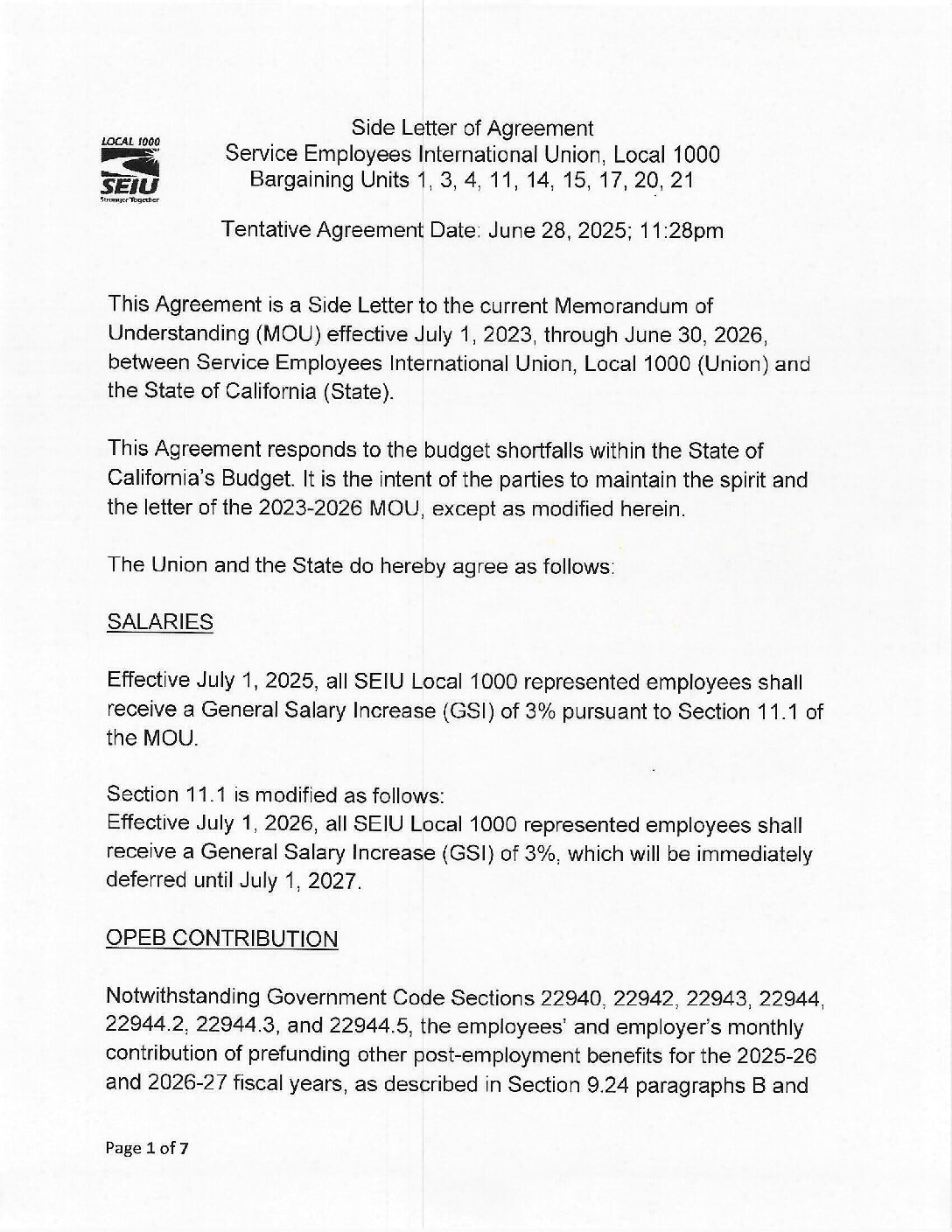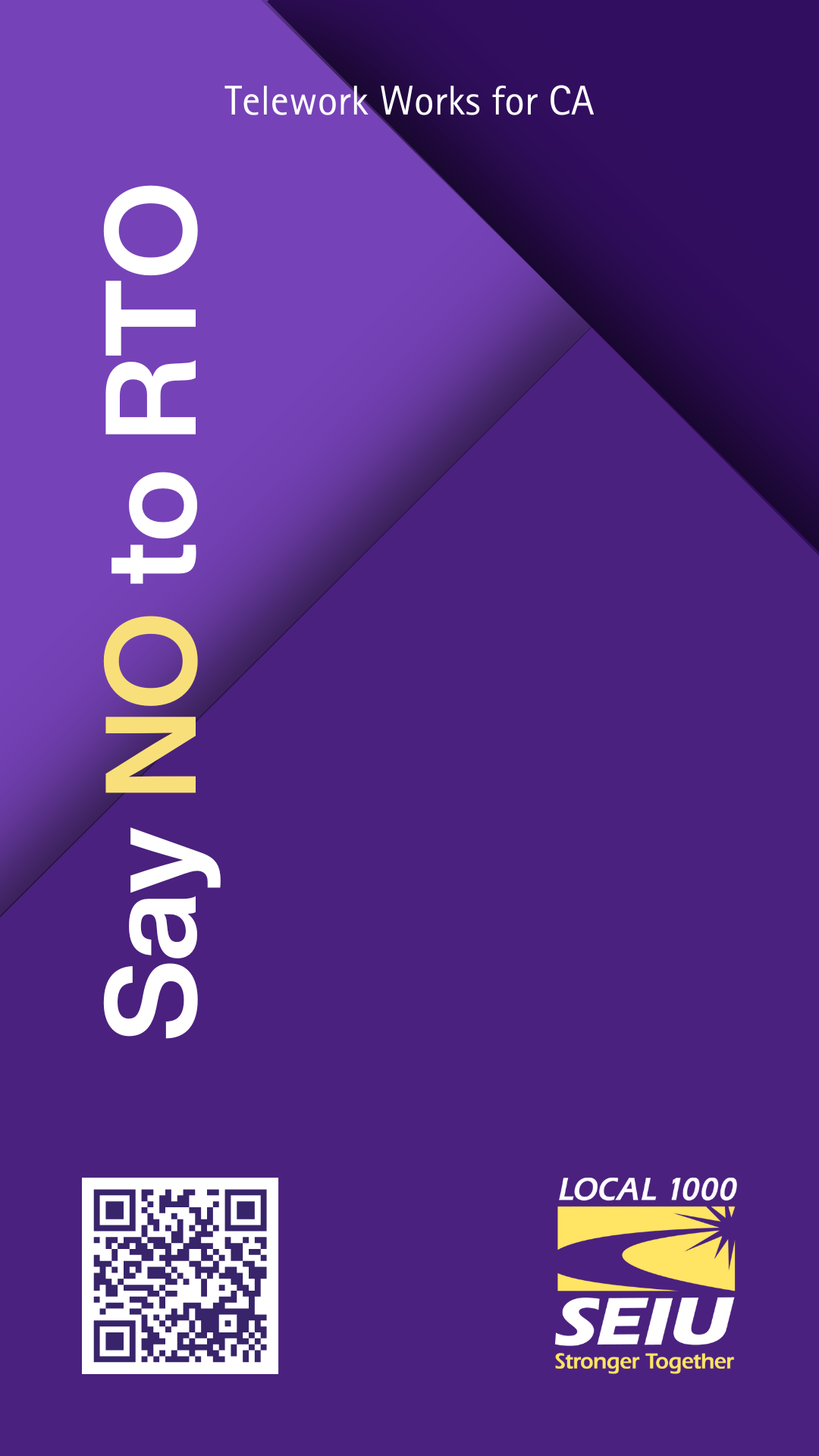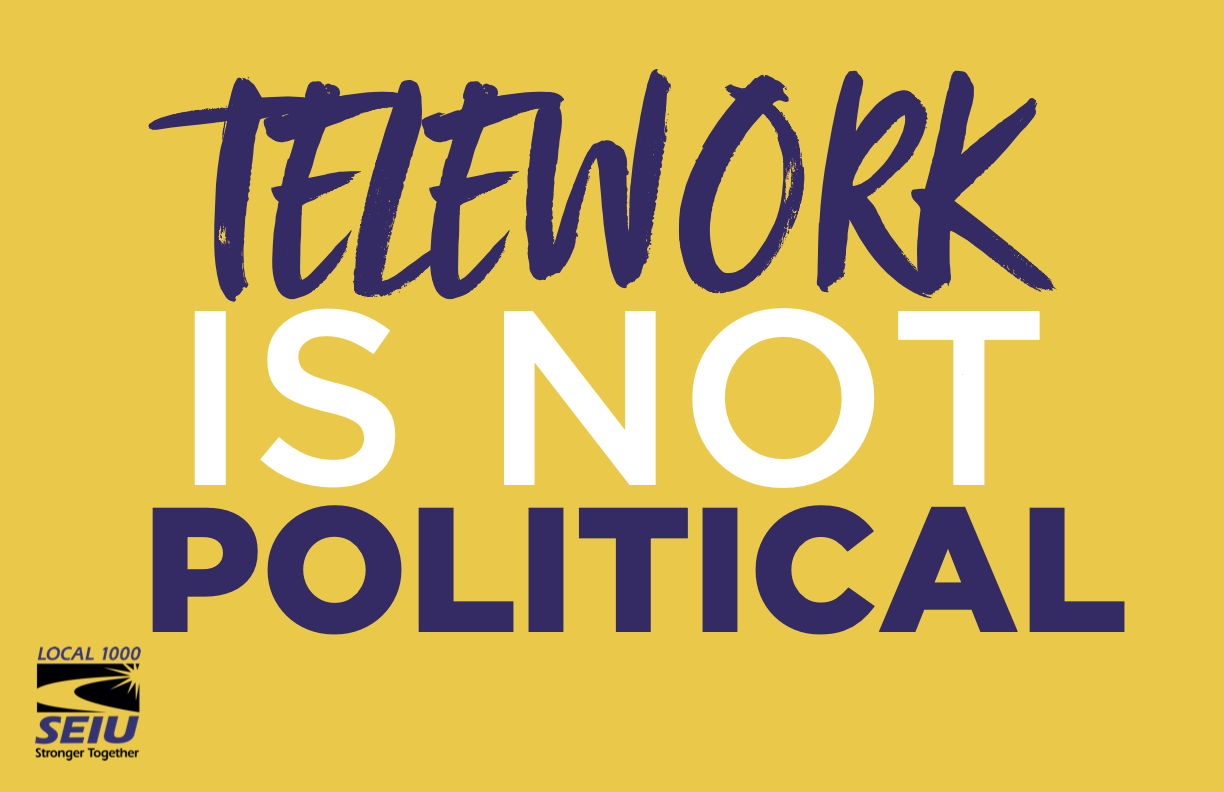
SEIU Local 1000’s fight against Governor Newsom’s Return-to-Office Mandate
Telework works.
It’s in the numbers. Check out the facts and figures that reflect telework’s efficiency below!
Telework Data: Savings, Equity, Efficiency (Click to expand)
The State of California and Scholars have recognized the savings coming from telework
- The 2022-23 California budget summary indicated that Department of General Services relinquished 767,000 sq. ft. of office space for an estimated $22.5 million in savings due to implementation of telework policies. (2022-23 California Budget Summary p.214 (PDF) Budget Summary and Governing, January 2022 California Lets 23 Leases Expire as Workers Stay Remote)
- Savings due to telework by the State of California workforce were projected at $84.7 million a year over the next three years. (2022-23 California Budget Summary p. 214 (PDF) Budget Summary)
- A methodological selection of studies show that telework is associated with higher productivity. A recent report published by PSOL One found that most of the articles they identified (59%) found that working from home was associated with higher productivity. A minority (27%) indicated instances of both increased and reduced productivity based on various moderating factors, and 14% showed decreases in productivity. (Hackney A, Yung M, Somasundram KG, Nowrouzi-Kia B, Oakman J, Yazdani A. Working in the digital economy: A systematic review of the impact of work from home arrangements on personal and organizational performance and productivity. Working in the digital economy: A systematic review of the impact of work from home arrangements on personal and organizational performance and productivity – PMC)
Telework supports working families in California
- “Parents of children under the age of 18 had a higher telework rate than workers with no children under 18 (21.4 percent compared with 18.7 percent, in August)” of 2023. (U.S. Bureau of Labor Statistics: Telework Survey, 2023. Highlights of CPS telework data : U.S. Bureau of Labor Statistics)
- According to a review of federal survey data on California telework by the California Center on Jobs and the Economy, when asked for the main reason why they worked from home nearly half of workers who did (46.3%) “indicated it was a personal preference or due to a need to coordinate work with personal and family needs.” (California Center on Jobs and the Economy, California Workers: Modernized Telecommuting Policies to Build Equity and Reduce Costs. October 2020 Telecommuting-FINAL.pdf)
Telework is a powerful recruitment and retention tool for employer
- A 2023 General Accounting Office review of telework studies reported that there’s evidence that telework allows employers to recruit from a larger pool of applicants, which can help to fill hard to fill positions. GAO-23-105999, TELEWORK: Growth Supported Economic Activity during the Pandemic, but Future Impacts are Uncertain
- In 2022, the journal Frontiers in Psychology published a systematic study of telework literature that showed that “when telework is voluntary, it appears that both actual employee turnover rates and intentions to leave the organization are lower.” A systematic review of the research on telework and organizational economic performance indicators – PMC (nih.gov) (Preface)
- At a time when state agencies are struggling with high vacancies in many critical positions, taking away telework -an important recruitment and retention tool that helps to fill positions- will make the dire problem of understaffing at state agencies even worse. This is particularly the case as baby boomers continue to move into retirement.
Telework reduces state employees carbon footprint
- According to an April 29th 2024 request for audit by Assembly Member Josh Hoover, state telework “eliminated nearly 400,000 metric tons of carbon emissions, reduced traffic congestion, and saved workers hundreds of dollars per month in vehicle expenses.” (California Assembly Member Josh Hoover letter to the Joint Legislative Audit Committee 2024-118 (Asm Hoover) Telework Revised (4-29-2024)_Signature Redacted.pdf)
- A California Department of General Services case study of telework at the agency found that teleworkers reduced their commute miles by 222,000 and “6500 hours during a typical week equating to approximately $30,000 in gas costs and avoidance of 80 metric tons of carbon dioxide emissions.” (DGS telework case study, Cal Telework Webpage. Website Accessed Feb 2, 2024. Link no longer available)
- A Sept. 2023 study on climate mitigation found that “switching from working on site to working from home can reduce up to 58 percent of work’s carbon footprint, and the impacts of IT use are negligible, while office energy use and non-commute travel impacts are important.” (PNAS, Brief Report: Climate mitigation potentials of teleworking are sensitive to changes in lifestyle and workplace rather than ICT (Information and communication technology usage. Sept. 2023.https://www.pnas.org/doi/pdf/10.1073/pnas.2304099120 )).
Telework Works
- According to recent U.S. Bureau of Labor Statistics survey data about 1 in 3 workers in management, professional, and related occupations teleworked. (U.S. Bureau of Labor Statistics: Telework Survey, 2023. Highlights of CPS telework data : U.S. Bureau of Labor Statistics)
| Major occupational group | All hours teleworked | Some hours teleworked | Total |
| Management, professional, and related | 16.4 | 18.4 | 34.8 |
| Sales and office | 12.0 | 9.6 | 21.6 |
| Service | 2.2 | 1.8 | 4.0 |
| Production, transportation, and material moving | 1.3 | 1.2 | 2.5 |
| Natural resources, construction, and maintenance | 0.7 | 1.5 | 2.3 |
| Note: Data are not seasonally adjusted. | |||
Telework and Workplace Equity in California
- As the state of California continues to strive towards more equitable workplaces and spaces, forcing state workers back into the office could potentially make things worse for everyone instead of expanding work from home options for workers who could do their jobs from home.
- Among people at work, women were more likely than men to have teleworked (21.6 percent compared with 17.7 percent, in August). (Highlights of Data on Telework, U.S. Bureau of Labor Statistics. August 2023. Highlights of CPS telework data : U.S. Bureau of Labor Statistics)
- Among the major race and ethnicity groups, Asians were more likely to have teleworked (31.2 percent) than Whites (19.3 percent), Blacks (15.4 percent), and Hispanics (9.9 percent). (Highlights of Data on Telework, U.S. Bureau of Labor Statistics. August 2023. Highlights of CPS telework data : U.S. Bureau of Labor Statistics)

Bargaining Agreement Reached: RTO Paused
June 29, 2025
We’ve reached an agreement with the State that protects your raise, pauses the return to office order, and gives us a path to bargain again in 2026.
Earlier this year, Governor Newsom and the State Legislature asked all unions to return to the table to address the state’s budget crisis. When they canceled our negotiated raise, SEIU Local 1000 pushed back. Through tough negotiations, we secured an agreement that defends what we won and limits the impact on workers.
Legal Action Against the Governor and CalHR
June 20, 2025
Today, on behalf of affected state employees, SEIU Local 1000 and President Anica Walls filed a lawsuit against Governor Gavin Newsom and the California Department of Human Resources (CalHR), challenging the legality of the Governor’s Return-to-Office (RTO) mandate that forces most state employees back into physical offices at least four days per week starting July 1, 2025.
This legal filing, known as a writ of mandate, was submitted in Alameda Superior Court and argues that the Governor’s order violates state law and the Administrative Procedure Act (APA) by imposing a major workplace policy—an illegal “underground regulation”—without legal authority, public input, or notice to our Union.
“This is not just about office attendance—it’s about transparency, accountability, and respect for the law,” said President Walls. “State workers successfully transitioned to telework during the pandemic, saving taxpayer dollars, reducing pollution, and improving service delivery. The Governor is now attempting to undo that progress behind closed doors and with unilateral action.”
Over the past several years, state departments have reduced office space and adapted to hybrid work, saving the state at least $700 million. Our filing highlights the enormous new costs it would take to reverse that shift—potentially costing taxpayers hundreds of millions of dollars each year—costs that were never considered in the state budget or legislative process.
We’re doing everything we can to protect the rights, health, and financial security of all the state employees we represent. This fight for fair and legal working conditions isn’t over. We’re demanding accountability—not empty promises—and we will keep pushing back against any effort to ignore the democratic process or silence our voices.
Next Stop — Formal PERB Hearing
June 19, 2025
After unsuccessful attempts to reverse the state’s decision through required settlement talks, Local 1000 is moving forward with a full evidentiary hearing to challenge the State’s unilateral imposition of a mandatory four-day Return-to-Office (RTO) policy.
Continue Reading...
During the settlement meeting, our Union called on the Governor to rescind the RTO mandate, arguing it was imposed in violation of the Dills Act — the law that protects our right to bargain over changes to working conditions. Local 1000 maintains that the order was issued without proper consultation or good-faith bargaining, overstepping what the State is legally allowed to do.
We’re committed to defending our members’ rights and the integrity of the bargaining process.
“Our position is simple: the State cannot disregard its duty to negotiate over matters that directly impact employees’ working conditions,” said President Walls. “We didn’t pick this fight, but we won’t back down from it either.”
The case now heads to a full evidentiary hearing before the Public Employment Relations Board (PERB), where the facts will be presented and a legal decision made.
PERB Conference on Thursday, June 19th
June 18, 2025
SEIU Local 1000 will appear before the Public Employment Relations Board (PERB) to fight back against the Governor’s Return-to-Office (RTO) mandate.
Continue Reading...
We filed an unfair practice complaint after the State unilaterally announced a major change to telework policy—without properly notifying our Union or giving us the chance to meet and confer, as required by our contract. The Executive Order mandating four in-person workdays per week violates the Dill’s Act, which protects our right to bargain and ensures existing telework agreements stay in place unless negotiated. This informal conference is a critical step in our legal fight to protect your telework rights.
California Department of Education (CDE) Reverses Course on RTO Mandate
June 9, 2025
Per Superintendent Thurmond, the California Department of Education (CDE) is NOT going back to the office four days per week!
PERB Issues Complaint in Response to SEIU Local 1000’s Unfair Practice Charge (UPC) Regarding the RTO Mandate
May 13, 2025
SEIU Local 1000 Files Legal Action to Challenge the RTO Mandate
March 3, 2025
Yesterday, SEIU Local 1000 officially filed an Unfair Practice Charge (UPC) with the Public Employment Relations Board (PERB), standing together with PECG workers in taking legal action against the Governor’s executive order on return to office. Read the full filing here.
Continue Reading...
This filing is a direct challenge to an unlawful mandate that violates our members’ collective bargaining rights under the Dills Act and disregards our contract. The Governor imposed this order unilaterally, without negotiation, without consideration for its impact on state workers, and without following the law.
We’re demanding that PERB rescind this illegal order immediately and return decision-making on telework and return-to-office policies back to individual departments, where it belongs. Agencies should be making operational decisions based on business needs – not political mandates.
Contact the Member Resource Center
If you believe you might qualify for a reasonable accommodation, start by contacting your department lead—this could be your first-line supervisor, personnel specialist, or HR department. They can provide details on your department’s return-to-work policies and the process for requesting accommodations. Once you have your department’s reasonable accommodation policy and telework agreement, contact the Member Resource Center (MRC) for guidance.
📞 Call: (866) 471-7348
🕒 Hours: Monday – Friday, 7 a.m. – 7 p.m.
The MRC can help you understand your options and navigate the request process.
Display Your Support for Telework on Zoom and Teams Calls!
Every time you use this background, you’re sending a powerful message: State workers have proven hybrid work works. It’s an easy, impactful way to show solidarity and raise awareness about the importance of continuing telework for California’s workforce.
Download Printable Flyers to Support Telework at Your Worksite
Download and print our Telework Works for CA flyers to post on bulletin boards, bring to union events, or use during worksite actions. It’s a simple, visible way to show solidarity and remind others that hybrid work works.










Telework was not only useful during the pandemic. Its benefits are endless; saves us high gas costs, minimizes toxic air pollution, rent costs for state offices, parking fees for employees, time spent driving in overcrowded freeways/streets, etc. It defeats the purpose of having city-funded e-bikes, scooters, e-vehicles that supposedly were meant to preserve the environment and yet we are now back to work everyday en masse. Why is the system contradicting its own efforts to preserve our environment?